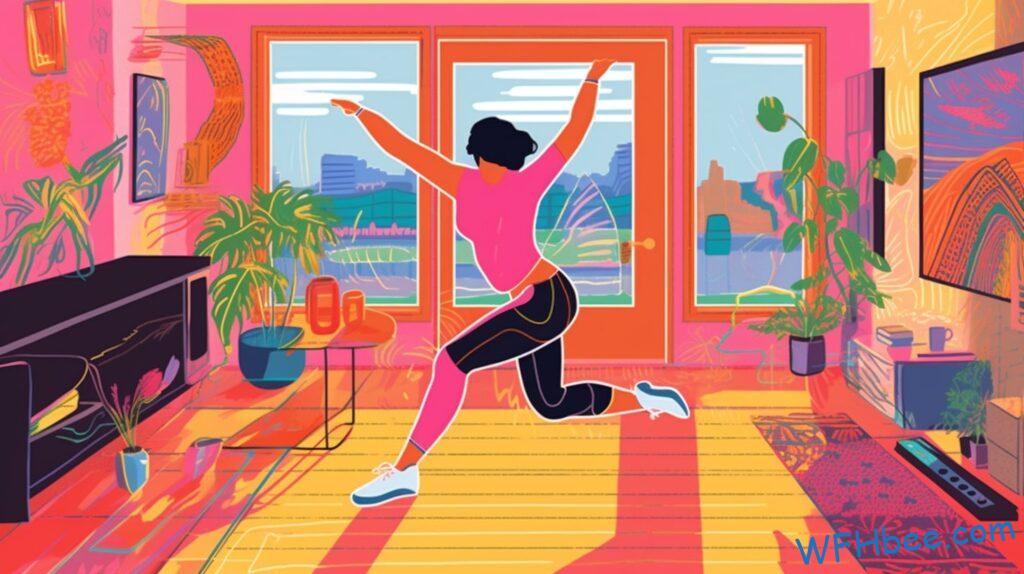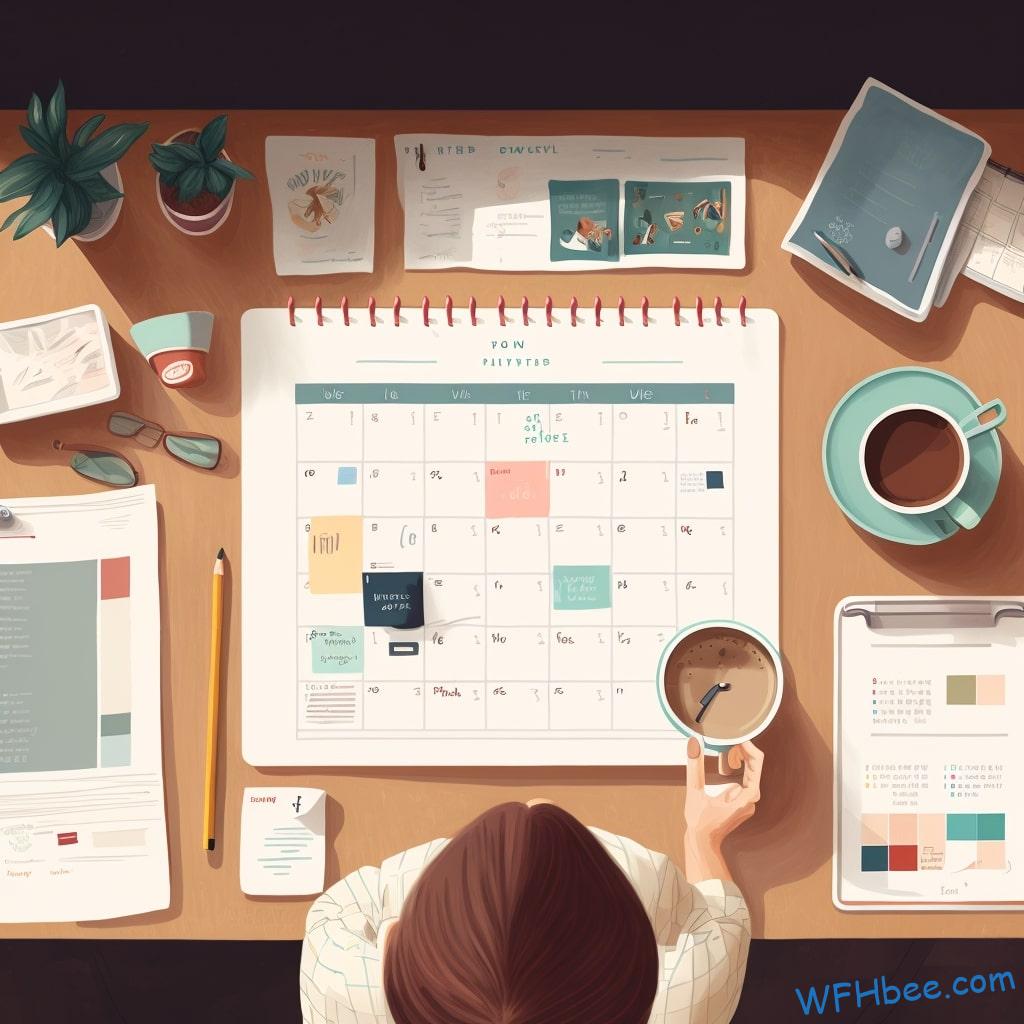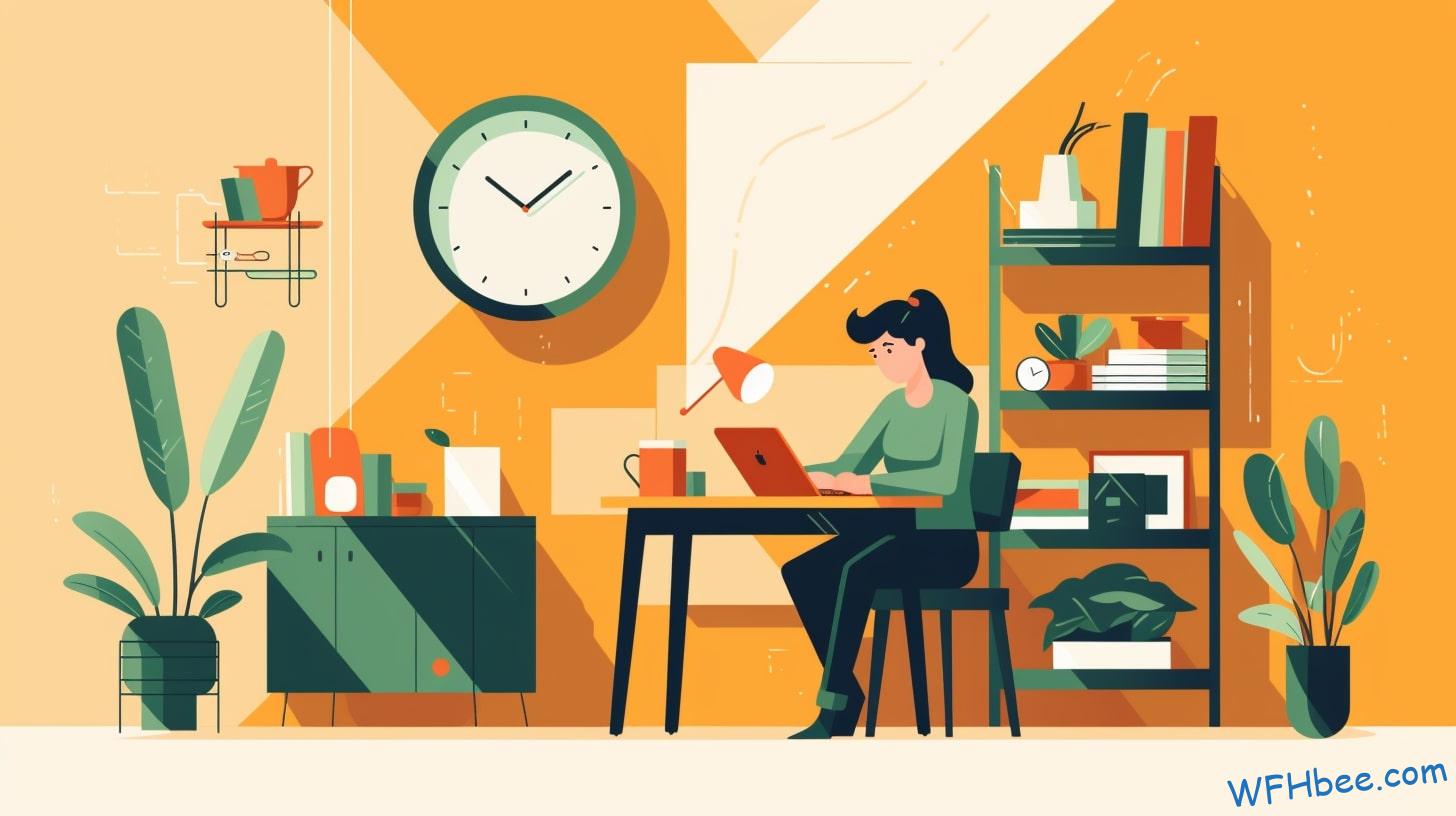We’re living in a world where working from home (WFH) is becoming more and more commonplace. While it has many advantages, like not having to commute or the ability to take breaks whenever you want, one of its main challenges is learning how to transition from work mode into personal mode when WFH. Doing this successfully can make all the difference between feeling energized and productive, or exhausted and overwhelmed.
In this article, we’ll discuss some simple tips for transitioning from work mode to personal mode so that you can enjoy your downtime without compromising on productivity during hours spent working from home. We will also address why it’s important to maintain a healthy balance between these two modes while still achieving success with remote work. Whether you’re an experienced professional looking for ways to maximize your time at home or just getting started with the WFH lifestyle, these tips are sure to help keep things running smoothly!
Finally, we will explore how making small changes in your day-to-day routine can have a big impact on both your mental health as well as your overall wellbeing – allowing you to achieve greater levels of freedom within your own life. So if you’ve been struggling with finding ways to switch off after clocking out each evening, then read on – because this article is going to provide you with some actionable advice for creating that much needed separation between work and leisure!

Table of Contents

Establish A Working From Home Routine
Establishing a routine is essential to transitioning from work mode to personal mode when working from home. A daily routine helps establish structure, so that you can create habits and set routines for yourself. It’s important to keep your day balanced and organized by having specific times of the day designated for certain tasks or activities. This could include scheduling time for leisurely activities such as reading, exercising, playing an instrument, taking walks outside, meditating etc. As well as allocating enough hours in the day for uninterrupted productive work.
It’s also helpful to take quick breaks throughout the day to give your mind some respite and recharge – even if it’s just five minutes here and there! Taking regular breaks ensures that you stay refreshed and motivated during working hours whilst avoiding burnout at the end of the day. With this strategy in place, you should find it easier to switch off after completing your workday duties without feeling guilty about not doing more.
To make sure you’re really making progress with achieving a better balance between life and work while WFH, it’s important to define clear boundaries around what counts as ‘work time’ versus ‘personal time’ each day.
Define Work Hours And Boundaries When Remote
According to a survey by the Bureau of Labor Statistics, 62 percent of full-time employees working from home reported feeling overwhelmed with their workload. To prevent burnout, it’s important to define work hours and establish boundaries that allow for relaxation during non-work hours.
Here are three tips on how to set rules and limits when transitioning from work mode to personal time:
- Set specific work hours – Define expectations about when you’re available for meetings or calls and make sure your colleagues know what times you’ll be online and offline. This will help keep yourself accountable, as well as help others respect your time away from work.
- Create a physical boundary between workspace and living space – Setting up a designated workspace can create an invisible barrier that helps separate your professional life from your personal one. By creating this distinction between the two environments, you’ll have an easier time switching into “off” mode when out of office hours arrive.
- Reduce distractions in both virtual and real spaces – Being aware of where potential distractions may come from is key in keeping focus while working remotely. That means turning off notifications on devices like cell phones or tablets while at work, setting parameters around who can contact you after business hours, or being conscious about leaving any personal items out of sight during video calls so they don’t become a distraction for either party involved.
These steps can go a long way in helping transition from work mode to personal time more smoothly when working remotely – enabling individuals to stay productive throughout their day without sacrificing quality outside-of-office leisure activities. Creating a dedicated workspace is another essential step towards having successful remote days!

Create A Dedicated Workspace At Home
Setting up a dedicated workspace at home is key for transitioning from work mode to personal mode. It doesn’t need to be fancy, although it should be comfortable and inviting enough that you enjoy spending time there. Start by figuring out the design of the space and what items are needed in order to make it an efficient place to work. Think about your computer setup, where documents will be stored, and other office essentials like stationary and filing cabinets.
Once you have determined the design of your home office or workspace, start by setting it up with all necessary furniture and materials. This could mean investing in some new pieces such as a desk, chair, shelving units, etc., or simply rearranging existing furniture if possible. Make sure to also add any decor elements that help create a pleasant atmosphere in the room – plants, wall art, lamps – whatever helps inspire creativity!
When designing your workspace, keep in mind how this environment can influence productivity levels when working from home. By creating an area that looks professional yet still feels cozy and inspiring at the same time, you can ensure an optimal balance between comfortability and efficiency throughout each day’s tasks. With a designated workspace set-up within your own home, it allows for easier transitions between work mode and personal mode without having to leave one physical location entirely. Now let’s look into separating professional tech devices from personal ones so we can stay organized even during our downtime.

Separate Professional From Personal Tech Devices And Accounts
Having a dedicated workspace is just the beginning of setting up your work from home lifestyle. To ensure that you are able to transition seamlessly between work and personal time, it’s important to separate professional and personal tech devices and accounts. This will help create boundaries so that when you’re in “work mode”, you’ll be more focused on getting tasks done quickly and efficiently without any distractions. Here’s how:
- Invest in two computers — one for professional use and one for personal use — if possible. That way you can keep track of what applications and websites are open at all times during your work day, ensuring nothing gets lost or forgotten about while transitioning into “personal mode”.
- Set up separate email accounts for professional and personal affairs; this will allow you to switch off after hours without worrying about being contacted by colleagues or clients late at night or over the weekend.
- Create different logins for various platforms such as Zoom or Slack, depending on whether they relate to your job or not; this way, any messages related to work won’t get mixed up with those relating to friends or family members who may also be using these services.
By taking the steps outlined above, you’ll be creating clear boundaries between your professional life and your personal life – helping make sure that when it comes time to relax, you don’t have anything interrupting your downtime! Now that we’ve looked at ways to separate our professional from our personal tech devices and accounts, let’s find ways to connect with colleagues and clients remotely even when working from home!
Find Ways To Connect With Colleagues And Clients Remotely
Connecting with colleagues and clients remotely might feel intimidating at first, but there are plenty of ways to make it easier. With the right tools and strategies in place, you can stay connected no matter where you’re working from.
First, find a platform that allows for easy communication between you and your colleagues or clients. A chat system like Slack is great for sharing documents and keeping everyone on the same page. You can also set up video conferencing software such as Zoom so that remote team collaboration remains seamless throughout the workday. This way, you’ll be able to communicate with each other quickly and efficiently without having to leave your home office space.
Second, try out different methods of connecting with clients remotely. When possible, use video calls instead of emails or phone calls so that both parties can have a more personal connection. If time permits, consider setting up online meetings through platforms such as Skype or Google Hangouts. These can help foster better relationships by allowing people to connect face-to-face even when they’re miles apart.
Lastly, don’t forget about other forms of communication outside of digital interactions, such as sending physical thank-you notes or cards to express appreciation for their support and contributions during this transition period. Taking the extra step to show your gratitude will go a long way towards strengthening client relationships while working from home.
These strategies will help ensure that all stakeholders remain engaged despite being unable to meet in person – now it’s time to identify opportunities to take breaks throughout the day so everyone involved has an opportunity to recharge before getting back into work mode again!

Identify Opportunities To Take Breaks Throughout The Day
Taking breaks throughout the day can open up a world of possibilities. It’s like unlocking an oasis of freedom while you are working from home. Breaks provide opportunities to take a step away from your work and enjoy some much-needed respite. With this in mind, let’s explore some ideas for taking regular breaks during the workday when WFH.
The key is to identify break opportunities that fit into your workflow, so that it feels natural and not disruptive or stressful. Working breaks could include scheduling time for lunch, setting aside quick 10-minute breaks throughout the day, or simply just stepping away for five minutes at certain points throughout the morning or afternoon. Break activities can also vary depending on what works best for you – stretching exercises, walking around outside (when possible), reading a book chapter, watching a funny YouTube video; all these activities can help clear your head and give you energy to keep working productively.
Creating space between tasks helps build productivity momentum by providing the opportunity to reset one’s focus and reframe their thinking before diving back into work. So use those mini-breaks as chances to pause and recalibrate yourself mentally and physically. This will enable you to be more productive overall with better quality output leading to greater job satisfaction! Now let’s move onto getting outside when possible…

Get Outside When Possible
When transitioning from work mode to personal mode, it’s important to get outside and connect with nature. Not only can outdoor activities offer a much-needed break during the day, but they also provide an opportunity to enjoy fresh air and reset your mind. Hiking is a great way to clear your head while exploring scenic trails in your area. Nature walks are another option that allow you to take in lush surroundings as you walk through wooded areas or along shorelines of local lakes or rivers. If you’re feeling adventurous, bird watching or kayaking might be just the ticket for reconnecting with nature.
No matter which activity you choose, getting outside offers numerous benefits that can help improve mental clarity and reduce stress levels. Even if it’s simply taking a few minutes for a quick stroll around the block or spending time in your backyard garden, engaging in physical activity outdoors will certainly help transition from work mode into personal mode more effectively.

Engage In Physical Activity
Engaging in physical activity is one of the best ways to transition from work mode to personal mode when working from home. It not only helps clear your mind and reduce stress, but also energizes you so that you can focus on more enjoyable activities. Here are a few ideas for transitioning through physical activity:
- Outdoor Activities:
- Going for a walk or jog around the neighborhood
- Playing catch with friends or family members (ensuring social distancing)
- Riding a bike along nearby trails
- Yoga & Aerobic Exercise:
- Streaming yoga classes online
- Joining virtual aerobic dance classes
No matter what type of physical activity you choose, make sure it’s something that will challenge your body while providing enjoyment. The key is to find an activity that you genuinely enjoy doing and stick with it. This way, transitioning into relaxation mode after work won’t be such a chore! With physical activity being part of your routine, making time for hobbies and interests becomes much easier and allows for greater freedom.

Make Time For Hobbies Or Interests
Take the time to explore your hobbies and interests by giving yourself permission to unplug from work mode. When you’re no longer bound to a traditional office, it can be hard to remember that taking breaks is important for both productivity and mental health. Jane Doe, a web designer who works remotely full-time remembers feeling overwhelmed when she first started working from home. She made sure to make some space in her schedule every day for activities outside of work such as painting or playing guitar. This allowed her to stay productive while also nurturing her creative outlets and exploring new passions.
When transitioning out of work mode, consider what other types of activities could bring joy into your life. You don’t have to limit yourself; think about all kinds of hobby ideas that interest you! Maybe there are certain topics you’d like to learn more about? Or interesting activities that would make an ideal weekend project? Whatever it is, take the opportunity now to find something that appeals to you and invest some time into it – even if it’s just 10 minutes a day!
Consider trying something completely different than what you usually do on a daily basis. Exploring new interests can help spark creativity and open up possibilities for learning skills that will add value in both your personal and professional life. Finding ways to nurture these creative outlets may lead you down paths you haven’t yet explored and allow you to discover things about yourself which could further enhance your well-being while being stuck at home during this pandemic.

Give Yourself Permission To Unplug
It can be hard to switch from work mode to personal mode, especially when you’re working from home (WFH). But it’s important for your health and wellbeing that you unplug when necessary. Don’t feel guilty about taking a break! Give yourself permission to do so and find balance between your work-life.
Start by setting clear boundaries. Determine how many hours each day you’ll dedicate to getting things done and stick to those hours. Then take time during the day or at night to focus on other areas of your life – whether that’s reading, exercising, connecting with friends or family, or doing something else entirely. It may seem like a daunting task at first but remember that this is an essential step in order to refocus after being ‘on call’ all day.
Make sure that you establish a routine before going full steam ahead into WFH life. This will help ensure that no matter what happens throughout the day, you have time set aside for yourself where your main goal is simply relaxation and recharging. The key here is carving out enough space in the week which allows for both productivity and leisure without feeling overwhelmed or overworked.
Take some moments every now and then away from screens and obligations; give yourself permission to just be in the moment without any expectations of what needs to get accomplished today or tomorrow. When we allow ourselves these moments of rest, our minds are better able to process information, leading us towards greater clarity as we move through our days. Finding meaningful ways to spend free time helps create harmony between work demands and personal desires which ultimately leads us closer toward achieving true balance while WFH.

Find Meaningful Ways To Spend Free Time
When the day is done, transitioning from work mode to personal mode can be difficult when working from home. It’s important to find meaningful ways to spend your free time and make sure you are taking care of yourself. Volunteering in the community or engaging with creative activities that explore interests can help break up monotony while also providing a sense of purpose.
Discover new hobbies by attending an online class or casually picking up a book on something you have been wanting to learn more about. Read books, listen to podcasts, cook new recipes; all these things can provide a unique outlet for creativity and growth when it comes to exploring different interests. Researching local volunteer opportunities like animal shelters or soup kitchens is another great way to give back and get connected with your community, even if it must be done virtually for now.
Taking part in any activity that inspires passion will ultimately create a positive shift in mindset and remind us why we do what we do each day: To live our best lives possible! Scheduling social interactions (like video calls) with friends and family gives us an opportunity for connection which helps restore balance both mentally and emotionally.

Schedule Social Interactions With Friends And Family
The importance of socializing remotely with friends and family is often overlooked. While it can be hard to stay connected when we’re all stuck in our own homes, there are numerous ways to make sure you don’t miss out on the fun! From virtual meetups to remote hangouts, staying socially engaged while working from home has never been easier.
Organize a video call with your closest friends or extended family members. This will give everyone the chance to catch up, share stories, and enjoy each other’s company without actually being together. You could even plan an online game night where participants get together via Zoom or Skype for some friendly competition! Additionally, you might try joining an existing group chat that focuses on shared interests like book clubs or movie nights.
Being able to connect with others during these difficult times can help reduce stress and anxiety levels caused by WFH arrangements. It also gives us something to look forward to every week – a way of escaping from our daily routines and connecting with people who understand how we feel. So why not take advantage of this opportunity and start scheduling regular meetings with your friends and family?
By taking the time for meaningful conversations and activities, you’ll find yourself feeling more relaxed and energized than ever before. The key here is to make sure that you’re still carving out quality time for yourself amid the chaos of work-from-home life – so don’t forget about managing stress through relaxation techniques as well!

Manage Stress Through Relaxation Techniques
We all need a break from work mode and to transition back into our personal lives. We can use relaxation techniques like mindfulness meditation, deep breathing exercises, yoga poses or other stress management practices to help us make the switch.
Mindfulness meditation is an effective way of calming your mind and body and allowing yourself to refocus on what’s important in life outside of work. It helps you gain perspective by appreciating moments throughout the day that bring joy and fulfillment. Deep breathing exercises are also beneficial for managing stress as they allow you to focus on controlling your breath rather than worrying about things out of your control. In addition, incorporating some simple yoga poses into your daily routine can be great for helping relax both physically and mentally.
Overall, these relaxation techniques will provide essential tools for transitioning from work mode to personal mode when working from home. They will help restore balance between the two aspects of life while keeping up with healthy habits that ensure overall well-being. The key is making time each day to prioritize self-care practices so we can continue living our best lives despite any challenges we face at work or otherwise.

Prioritize Self-Care Practices
It’s essential to prioritize self-care practices when transitioning from work mode to personal mode. Self-care practices can help reduce stress, improve mental health and foster healthy habits. Incorporating an element of physical activity into your day is a great way to ensure that you are taking care of yourself as well as enabling a smooth transition from working hours to leisure time. This can be anything from going for a walk outside or stretching at home; the goal being creating a routine around self-care rituals.
The importance of having a balanced lifestyle cannot be stressed enough when it comes to leading a healthy life while working remotely. Finding ways to relax such as listening to music, reading books, cooking meals, or socializing with family and friends on video calls will create positive energy in our lives which is especially beneficial during this unprecedented period of remote work. Additionally, regular breaks throughout the day should be taken so that every task feels manageable and not overwhelming.
Creating boundaries between work and personal life by setting alarms for starting and ending times helps avoid burnout, which is common among those who do not take proper restorative measures after completing their tasks each day. Taking these steps towards bettering one’s state of mind enables efficient productivity while also allowing us to make the most out of our free hours without feeling overwhelmed or anxious. Evaluating your performance regularly is key in order to achieve success both professionally and personally!

Evaluate Your Performance Regularly
Have you ever felt like work has taken over your life? Working from home can often blur the lines between professional and personal responsibilities, making it difficult to transition out of ‘work mode’. One way to help with this is to take regular breaks for self-evaluation and performance review.
This type of assessment allows us to measure our efficiency, track our progress, and identify areas for improvement. An effective approach would be to schedule a weekly or monthly performance check-in where you can analyze how well you have been utilizing your time during your working hours, as well as checking if you are meeting all of your goals. This will also give you an opportunity to reflect on what was successful – and not so successful – in terms of job performance throughout that period.
Remember that self-assessment doesn’t only involve examining past results; it also involves considering future plans. During these evaluations, think about any changes or adjustments which could increase productivity going forward. Adjustments may include adjusting break times or setting more realistic expectations for yourself when tackling tasks at hand. It’s important to keep an open mind when assessing yourself; don’t forget that being too hard on yourself is counterproductive!
Evaluating your performance regularly is essential in order to prevent burnout while WFH and remain productive – both professionally and personally. Therefore, make sure to build self-checkpoints into your daily routine by scheduling regular times dedicated solely towards evaluating and improving your workflow.

Concluding Thoughts
Working from home has its challenges, but by following the tips outlined above you can successfully transition between work and personal modes. It may take some time to adjust to this new way of working, which is why it’s important to establish a routine and define clear boundaries for yourself. Take the time to invest in your own well-being—from scheduling social interactions with friends and family, to prioritizing self-care practices like exercise and relaxation techniques. This will help ensure that you’re not only productive at work, but also feeling fulfilled outside of office hours.
When transitioning from work mode to personal mode while WFH, remember that there’s no one size fits all approach – everyone is different! As they say ‘it takes two steps forward and one step back’ so don’t be too hard on yourself if things aren’t perfect right away. With dedication and commitment, gradually you’ll find what works best for you; like pieces of a jigsaw puzzle slowly coming together until finally forming an image clearer than ever before.
Making sure that our professional lives are balanced with our personal ones is essential when working remotely. By taking control of your environment and listening to your body, you’ll have the power to create harmony between these two worlds; allowing both career success as well as personal fulfillment within reach.
Author: Robin Borg
Hi, I’m Robin. I have been working from home at least one day a week during all of my adult life. I have a background in research and data science. Get to know me better in the About page.







